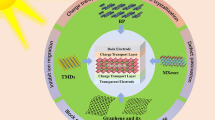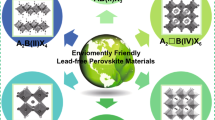Abstract
Halide perovskites have attracted great attention from many researchers recently, particularly for their excellent optoelectronic properties in applications such as photovoltaic solar cells. In recent years, perovskite solar cells (PSCs) have made great progress with a power conversion efficiency exceeding of 26% comparable to single-crystal silicon solar cells, but the stability issue still limits commercialization. PSCs allow the absorption of large amounts of photons compared to Si solar cells and have a thin layer. This provides a great advantage in terms of cost. Another important advantage of perovskite is its long diffusion path and high carrier mobility. The degradation of PSCs is mainly due to oxygen, moisture, light and heat caused by external environmental factors. In this study, we use natural clays instead of synthetic porous materials. The clays were selected according to their chemical structure and solvent dispersibility. Montmorillonite, laponite, halloysite and Na-bentonite were used in this research. Significant improvements were observed using clays as scaffold. The improvement in efficiencies were observed around 5% with montmorillonite, 13% with halloysite and 7% with laponite in comparison with reference cell. These results show that those clays can be alternative natural, non-toxic and low-cost materials as scaffold layer in PSCs.




Similar content being viewed by others
Data availability
The authors declare that the datasets and results obtained and/or analyzed during the current study are available from the corresponding author on reasonable request. All data generated or analyzed during this study are included in this published article.
References
J. Park, J. Kim, H.-S. Yun, M.J. Paik, E. Noh, H.J. Mun, M.G. Kim, T.J. Shin, S.I. Seok, Controlled growth of perovskite layers with volatile alkylammonium chlorides. Nature 616(7958), 724–730 (2023)
T. Salim, S. Sun, Y. Abe, A. Krishna, A.C. Grimsdale, Y.M. Lam, Perovskite-based solar cells: impact of morphology and device architecture on device performance. J. Mater. Chem. A 3(17), 8943–8969 (2015)
E. Yenel, M. Kus, A novel natural scaffold layer improving efficiency, stability and reproducibility of perovskite solar cells. Sci. Rep. 13(1), 4319 (2023)
W. Li, H. Dong, L. Wang, N. Li, X. Guo, J. Li, Y. Qiu, Montmorillonite as bifunctional buffer layer material for hybrid perovskite solar cells with protection from corrosion and retarding recombination. J. Mater. Chem. A 2(33), 13587–13592 (2014)
H.-H. Huang, Y.-C. Shih, L. Wang, K.-F. Lin, Boosting the ultra-stable unencapsulated perovskite solar cells by using montmorillonite/CH3NH3PbI3 nanocomposite as photoactive layer. Energy Environ. Sci. 12(4), 1265–1273 (2019)
N.K. Elumalai, A. Uddin, Hysteresis in organic-inorganic hybrid perovskite solar cells. Sol. Energy Mater. Sol. Cells 157, 476–509 (2016)
X. Yu, S. Chen, K. Yan, X. Cai, H. Hu, M. Peng, B. Chen, B. Dong, X. Gao, D. Zou, Enhanced photovoltaic performance of perovskite solar cells with mesoporous SiO2 scaffolds. J. Power. Sources 325, 534–540 (2016)
M.M. Lee, J. Teuscher, T. Miyasaka, T.N. Murakami, H.J. Snaith, Efficient hybrid solar cells based on meso-superstructured organometal halide perovskites. Science 338(6107), 643–647 (2012)
R.B. Furlong, Electron diffraction and micrographic study of the high-temperature changes in illite and montmorillonite under continuous heating conditions. Clays Clay Miner. 15, 87–101 (1967)
F. Zhang, J. Song, L. Zhang, F. Niu, Y. Hao, P. Zeng, H. Niu, J. Huang, J. Lian, Film-through large perovskite grains formation via a combination of sequential thermal and solvent treatment. J. Mater. Chem. A 4(22), 8554–8561 (2016)
X. Lin, A.S. Chesman, S.R. Raga, A.D. Scully, L. Jiang, B. Tan, J. Lu, Y.B. Cheng, U. Bach, Effect of grain cluster size on back-contact perovskite solar cells. Adv. Func. Mater. Func. Mater. 28(45), 1805098 (2018)
G. Yang, C. Wang, H. Lei, X. Zheng, P. Qin, L. Xiong, X. Zhao, Y. Yan, G. Fang, Interface engineering in planar perovskite solar cells: energy level alignment, perovskite morphology control and high performance achievement. J. Mater. Chem. A 5(4), 1658–1666 (2017)
Acknowledgements
We would like to TÜBİTAK (PN:121F183) for financial support of this work. Gamze Dölek would like to thank to TÜBİTAK (2211C programme) for scholarship support of her thesis and this work. We declare that the data used in this study are partially derived from Gamze Dölek's PhD thesis and Buse Nur Bütün's Master's thesis.
Funding
We acknowledge that this work was supported by The Scientific and Technological Research Council of Türkiye (TÜBİTAK Project number: 121F183).
Author information
Authors and Affiliations
Contributions
In this work, material preparation and experiments were performed by GD and BNB, data collection and analysis were performed by MK and EY. The first draft of the manuscript was written by EY and all authors commented on previous versions of the manuscript. All authors read and approved the final manuscript.
Corresponding author
Ethics declarations
Conflict of interest
The authors declared that they have no affiliations with or involvement in any organization or entity with any financial or non-financial interest, in the subject matter or materials discussed in this manuscript. The authors have no relevant financial or non-financial interests to disclose.
Consent for publication
The manuscript was only submitted to the journal named as ‘‘Journal of Materials Science: Materials in Electronics.’’ The authors have certified that this manuscript was not submitted to any journal for simultaneous consideration. The authors declare that the submitted results in the manuscript are original and any part of them had not been published elsewhere in any form or language (partially or in full), and this study was not split up into several parts for increasing publication number. The authors endorsed that all results introduced in this study were presented clearly, honestly, and without fabrication, falsification, or inappropriate data manipulation.
Research involving human and animal participants
This study did not involve any experiments on animals or humans.
Additional information
Publisher's Note
Springer Nature remains neutral with regard to jurisdictional claims in published maps and institutional affiliations.
Supplementary Information
Below is the link to the electronic supplementary material.
Rights and permissions
Springer Nature or its licensor (e.g. a society or other partner) holds exclusive rights to this article under a publishing agreement with the author(s) or other rightsholder(s); author self-archiving of the accepted manuscript version of this article is solely governed by the terms of such publishing agreement and applicable law.
About this article
Cite this article
Yenel, E., Dölek, G., Bütün, B.N. et al. Improved efficiency and stability of perovskite solar cells based on clays. J Mater Sci: Mater Electron 34, 2282 (2023). https://doi.org/10.1007/s10854-023-11728-5
Received:
Accepted:
Published:
DOI: https://doi.org/10.1007/s10854-023-11728-5




